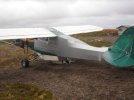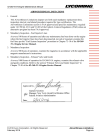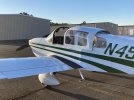You are using an out of date browser. It may not display this or other websites correctly.
You should upgrade or use an alternative browser.
You should upgrade or use an alternative browser.
Can IA ground plane for airworthiness outside of annual inspection?
- Thread starter AlleyCat67
- Start date
AlleyCat67
Pre-takeoff checklist
- Joined
- Oct 5, 2017
- Messages
- 398
- Display Name
Display name:
AleyCat67
In
The shop is in Maryland. I’ll talk to them next week, raise the points made on this thread, and hopefully put things right. I don’t want to publicly shame them until they’re given a chance to respond. The “I can’t release your plane” was a five minute conversation and I didn’t press the issue at the time since I wasn’t 100% clear on the regs.Again, what facility is this, at least what state is it located in?
Ed Haywood
En-Route
That just heightens the silliness. Grounding an aircraft for a crack in a flimsy plastic part that is probably 95% cosmetic in function is just ridiculous. Speed tape the dang thing while you find materials to do a more permanent repair. Or pop rivet a strip of aluminum behind the crack while you wait for a new part.You're absolutely right - it's ABS not fiberglass. I did recommend Fletch Air - I think they may have started with Fletch and then gone directly to the manufacturer. Thanks.
I am flying with a fist sized hole in my side window right now. IA had zero issues with taping it over while we wait for Cee Bailey's to ship a new one.
And then there's this guy:

Having said all that, you get more flies with honey. Quoting regs to the DOM will probably just trigger his latent authority complex and cause him to dig in. Asking nicely for help and suggesting alternatives may be aggravating, but is more likely to resolve the situation.
Last edited:
One of the missing facts here, is the size and shape of the crack that was stop drilled'
I have dealt with this issue on metal parts that the home field mechanic wished to replace, rather than stop drill. We had a mechanic from another field come, determine that the plane was airworthy, and fly it to his shop for repairs. Our next annual was not at our home field, naturally.
I have dealt with this issue on metal parts that the home field mechanic wished to replace, rather than stop drill. We had a mechanic from another field come, determine that the plane was airworthy, and fly it to his shop for repairs. Our next annual was not at our home field, naturally.
Wise choice. Not issuing a maintenance release is different than “grounding” the aircraft. The question is in what context prevents the signing of the mx release: CRS procedure or the subjectiveness of the final inspector over the cracked cone. Perhaps inquire on a repair for the crack vs replacement if one is not available? Good luck.The “I can’t release your plane” was a five minute conversation and I didn’t press the issue at the time since I wasn’t 100% clear on the regs.
SoCal 182 Driver
Cleared for Takeoff
- Joined
- Sep 11, 2019
- Messages
- 1,068
- Display Name
Display name:
SoCal 182 Driver
I brought my plane (AA-5B) in for repainting a month ago, and was informed by their A&P/IA that because of a stop-drilled crack in the fiberglass tail cone the plane was "unairworthy".
A picture of the stop-drilled crack would be helpful for this discussion.
As was said; there made be more to this story. In the first place is why is
the tail cone cracked ? Some aircraft are sensitive to proper positioning
of the unit and correct screw installation. If not done correctly the control
will catch on the tailcone. I wouldn’t release that either.
the tail cone cracked ? Some aircraft are sensitive to proper positioning
of the unit and correct screw installation. If not done correctly the control
will catch on the tailcone. I wouldn’t release that either.
Silvaire
En-Route
- Joined
- Oct 10, 2012
- Messages
- 4,679
- Display Name
Display name:
Silvaire
Well technically "I can't release your plane" does not mean that you can't take it out of the shop. It just means he can't (or won't) sign your log book as "returned to service" They have absolutely no authority to hold your aircraft from you or even stopping you from flying it out of there.
On the chance that it might help your conversation with the maintenance shop, here is a copy of relevant pages from the Tiger maintenance manual. See the section "Repair of Thermoplastic Parts". Also see the parts list #36, Tailcone - Thermoplastic.
Attachments
Ed Haywood
En-Route
No. In general, only an Airworthiness Limitations section within a service manual would be "approved data." The rest is acceptable data. Some OEMs have approved structural manuals but usually not in the case of SE GA aircraft. However, I doubt a repair to a tailcone fairing would fall under a major repair which would need approved data to fix.TC holder service manual would be approved data, correct?
I believe that when Ed Haywood wrote TC holder Service Manual he was referring to the Type Certificate Holder's Maintenance Manual, and your reference to only the Airworthiness Limitations section being "approved data" is referring to the Owner's Manual (where the Airworthiness Limitations Section is the only section that is regulatory). A Maintenance Manual (at least none of the ones that I've seen) doesn't have an Airworthiness Limitations section. I believe that the official Maintenance Manual is approved data.No. In general, only an Airworthiness Limitations section within a service manual would be "approved data." The rest is acceptable data. Some OEMs have approved structural manuals but usually not in the case of SE GA aircraft. However, I doubt a repair to a tailcone fairing would fall under a major repair which would need approved data to fix.
Ed Haywood
En-Route
The maintenance manual for my 78 Bellanca Decathlon does not have the TCDS number or document number, unlike the various other TC specification documents I have referenced as approved data during my restoration. That leads me to suspect that, at least in my case, the service manual is not "FAA approved."
Kristin
Pattern Altitude
- Joined
- Dec 1, 2013
- Messages
- 1,659
- Location
- Twin Cities
- Display Name
Display name:
Kristin (The Aviatrix)
The TC holder Service Manual is only acceptable data, not "approved" data. Minor repairs and alterations only require acceptable data.I believe that when Ed Haywood wrote TC holder Service Manual he was referring to the Type Certificate Holder's Maintenance Manual, and your reference to only the Airworthiness Limitations section being "approved data" is referring to the Owner's Manual (where the Airworthiness Limitations Section is the only section that is regulatory). A Maintenance Manual (at least none of the ones that I've seen) doesn't have an Airworthiness Limitations section. I believe that the official Maintenance Manual is approved data.
Ed Haywood
En-Route

FAA Feedback: Approved Data
Is the STC “approved” data or is it “acceptable” data?
"Acceptable data is found in aircraft maintenance documents such as manufacturer’s maintenance manuals, service bulletins and letters, advisory circular AC 43.13-1A and 2A, and FAR Part 121 and Part 135 air carrier maintenance manuals."
Ed Haywood
En-Route
I think we all agree this is a minor repair and needs acceptable data, which the Grumman manual provides. The only reason I brought it up was that @Bell206 said that CRS were not allowed to use acceptable data.
Which begs the question: what happens when no approved data exists? Is the CRS unable to perform that repair, even though it is minor?
Which begs the question: what happens when no approved data exists? Is the CRS unable to perform that repair, even though it is minor?
In general terms, until 1980 small airplane Airworthiness Limitation Sections or listings of life-limited parts could be found in various manuals depending on the OEM or vender, if required. And prior to the change to the FARs most life-limited parts were listed in the Aircraft Specifications/TCDS. But keep in mind, it was rare for any small airplane to have life-limited parts up through the 60s-70s. After 1980, guidance was put in place to require the ALS be placed in the main maintenance document (manual). And even though there was no regulatory requirement in most cases the industry followed that when updating their manuals and certifications. For example, the latest variant Lycoming IO-360 manual:your reference to only the Airworthiness Limitations section being "approved data" is referring to the Owner's Manual (where the Airworthiness Limitations Section is the only section that is regulatory). A Maintenance Manual (at least none of the ones that I've seen) doesn't have an Airworthiness Limitations section.

As mentioned above, an OEMs ICAs (MM, IPC, SRM, etc) are only acceptable data which is discussed in a number of guidance docs. An example below. There are also times when an OEM does have a specific ICA like some SRMs or SBs FAA-approved. However, the vast majority of the manuals are not approved or only sections like in an AFM are actually FAA-approved.I believe that the official Maintenance Manual is approved data.

I believe I was answering the part having to use approved data for minor repairs? To clarify, a CRS can use all kinds of data, to include their own developed proprietary data. However, any data used must conform to the processes covered in their RSM/QCM in order to use it. Nothing more.The only reason I brought it up was that @Bell206 said that CRS were not allowed to use acceptable data.
If no data exists the CRS can develop their own data AND approve it in-house if they have the required designees. If you or me needed approved data our only options would be through a DER or ASI.Which begs the question: what happens when no approved data exists? Is the CRS unable to perform that repair, even though it is minor?
Are there minor repairs a CRS can't perform? Sure. Especially if the aircraft, component, or repair does not fall under their approved ratings or capabilities list. For example, if you brought your Decathlon to my CRS for a minor fabric repair, but my CRS capabilities list only permitted metal skinned aircraft repairs, I could not technically perform the repair under a CRS process or workorder. However, I could still pull the aircraft into my shop and perform the fabric repair but I would have to sign it off under my A&P and not the CRS workorder process. If that makes sense.
Attachments
Last edited:
chemgeek
En-Route
- Joined
- Dec 5, 2009
- Messages
- 3,103
- Display Name
Display name:
chemgeek
The tail cone of the AA-5X series is an ABS plastic non-structural piece that is comically easy to repair. I've repaired several of these types of cracks in ABS fairings under A&P supervision. The technique has already been described in prior posts. I don't really understand why a crack in one of these fairings would be a show-stopper. Just fix it as necessary using the approved method and move on...
AlleyCat67
Pre-takeoff checklist
- Joined
- Oct 5, 2017
- Messages
- 398
- Display Name
Display name:
AleyCat67
I'll take it as a "win". I got the plane back this week, and the paint looks good (simple design, but its what I wanted). The plastic tail cone ended up being specially fabricated by Vantage Plane Plastics since they were apparently out of stock. The paint shop A&P still maintained that the original crack couldn't be repaired (said he didn't find repairs to ABS to ever be reliable). I didn't feel like arguing with him about that, so just grabbed the plane and took it home. Now I can get back to flying!

Glad the tailcone partially worked out. That paint looks slippery slick, though. I'll bet it added 5 kts TAS!I'll take it as a "win". I got the plane back this week, and the paint looks good (simple design, but its what I wanted). The plastic tail cone ended up being specially fabricated by Vantage Plane Plastics since they were apparently out of stock. The paint shop A&P still maintained that the original crack couldn't be repaired (said he didn't find repairs to ABS to ever be reliable). I didn't feel like arguing with him about that, so just grabbed the plane and took it home. Now I can get back to flying!
View attachment 123306

